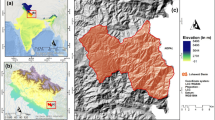Abstract
Shuttle Radar Topographic Mission (SRTM) data have been used in this study for mapping the terrain characteristics of the Egyptian territory. The 30 arc second (=900 m) resolution data is found to be the most suitable for the national scale mapping. The Egyptian political boundary was used to clip USGS GTOPO_U30 topo data Digital Elevation Model (DEM) for the Egyptian terrain. Using the DEM produced by the SRTM, different GIS layers were created using the ARC/G1S 9.0 software. These layers include all the necessary base map layers for terrain analysis, namely Contour, Elevation zones, Slope angle, Aspect, Hillshade, Drainage network and basins. Each layer map gives a clear idea about one parameter of the terrain as elevation zone map explains the topography distribution, highest and lowest altitudes. Slope angle map shows the distribution of sleep and gentle slope areas in Egypt. Aspect map explains the direction of the land slope differentiating as example areas facing north from others facing south. Hillshade map classifying Egyptian terrain into areas with more or rare shade, Maps of the drainage network and basins outlines the Egyptian terrain into different drainage basins regarding the surface runoff and consequently point out areas vulnerable to flash flood hazard and others with more probability for ground water supply. A rather new idea of creating an active, desktop for the Egyptian terrain is established. This active desktop gives the values of five parameters for a chosen point by using the cursor These terrain five parameters include values of X. Y, Z, slope angle and Aspect. The study of terrain characteristics is essential for strategic Planning and pre-planning decisions. Unveiling the land potentials and constraints, the terrain characteristics related to surface analysis and GIS cartographic modeling is a decision support tool.
Access this chapter
Tax calculation will be finalised at checkout
Purchases are for personal use only
Similar content being viewed by others
References
Arc GIS9 Desktop Software Help References
ERDAS imagine 8.5 Field Guide, 2004
Heffni K, Shatta A (2004) The underground water in Egypt. The ministry of water resources and irrigation. ARTS Press,
Shuttle Radar Topography mission (2000) United States geological survey (USGS). On-line satellite data. Accessed 2005
The Global Land Cover Facility (GLCF) University of Meryland. On-line satellite data. Accessed 2005
Author information
Authors and Affiliations
Corresponding author
Editor information
Editors and Affiliations
Rights and permissions
Copyright information
© 2010 Springer-Verlag Berlin Heidelberg
About this chapter
Cite this chapter
Hegazy, M.N., Effat, H. (2010). Exploring the Egyptian Terrain Characteristics from Space for Strategic Planning. In: Gökçekus, H., Türker, U., LaMoreaux, J. (eds) Survival and Sustainability. Environmental Earth Sciences. Springer, Berlin, Heidelberg. https://doi.org/10.1007/978-3-540-95991-5_75
Download citation
DOI: https://doi.org/10.1007/978-3-540-95991-5_75
Published:
Publisher Name: Springer, Berlin, Heidelberg
Print ISBN: 978-3-540-95990-8
Online ISBN: 978-3-540-95991-5
eBook Packages: Earth and Environmental ScienceEarth and Environmental Science (R0)




